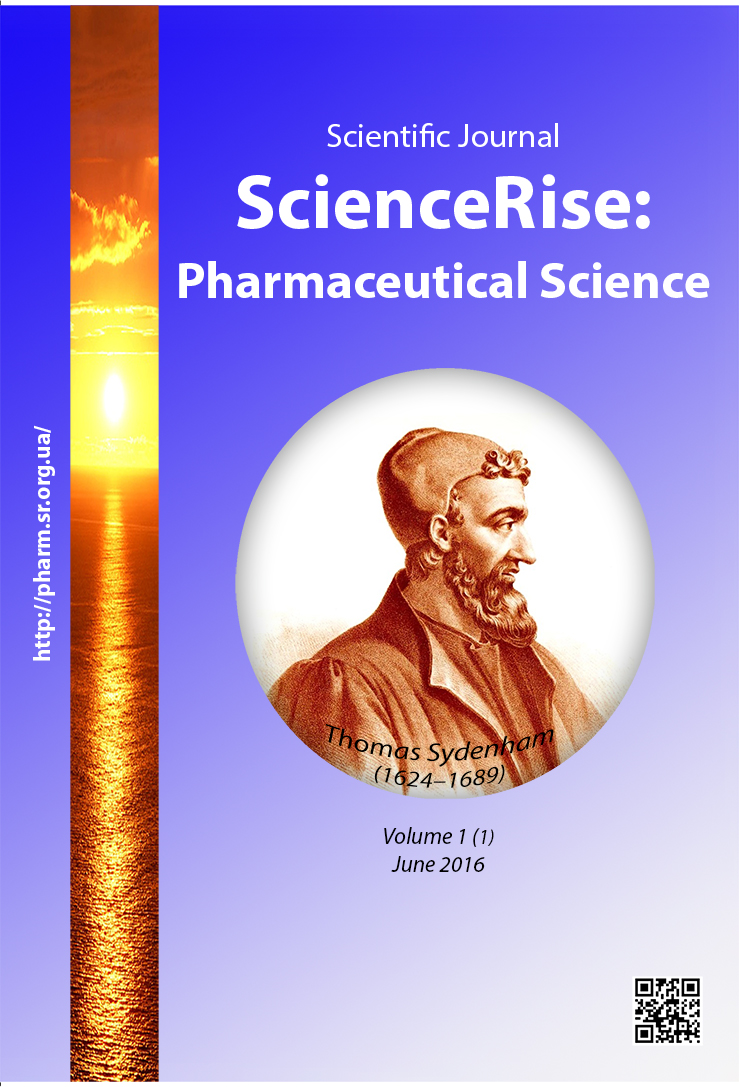The ointment containing Ag@Fe3O4 for removal and treatment of skin neoplasms
DOI:
https://doi.org/10.15587/2519-4852.2016.72550Keywords:
nanoparticles, magnetocontrollable composite system, silver shell, magnetite ointment, cryoscopyAbstract
Aim. Priorities for improving the thermal conductivity values and the external controllability of the process of cryosurgical intervention have determined. The aim of this work is creation of soft dosage forms with a highly heat-conductive magnetic carrier of the multifunctional action for removal and treatment of skin neoplasms.
Methods. At the initial stage the required parameters and properties of the magnetic component introduced into the composition of magnetocontrollable ointments have been determined. The screening of the antimicrobial activity in terms of the impact of the composite on strains of microorganisms and fungi has been carried out. The magnetite ointments have been tested by the cryodestruction method of removal and treatment of skin neoplasms. For this purpose a special portable apparatus CRY-AC (Brymill) and a contact cryoprobe with nozzles are used.
Results. Based on the results of the research of the magnetic properties of the composite nanoparticles the sample has been selected, it has a high value of saturation specific magnetization σ = 62.5 еmu/g, the nanoparticle size (23 nm) has been determined. The presence of silver on the surface of magnetic nanoparticles makes a significant additional contribution to the thermal conductivity of the composite (the thermal conductivity coefficient of magnetite χ is ~ 5.3 W/(m × K), silver is ~ 420 W/(m × K)), being one of the valuable properties for using it in cryosurgery.
The composition of magnetocontrollable ointments I and II for cryodestruction and post-operative treatment of skin neoplasms has been developed and improved by the main magnetic indicators.
Conclusions. To order to use ointments with a magnetic filler in cryosurgery the magnetic carrier of the "core-shell" type – Ag@Fe3O4 with the islet silver coating has been synthesized and tested.
The advantages of the magnetite ointments with silver in cryointervention and postoperative treatment of skin neoplasms have been found. The use of ointment I has contributed to increase of the analgesic effect by 28 %, and decrease of the cryosurgery duration by 50 %. For the subsequent treatment and healing of wounds after surgical procedures ointment II is used, it improves the post-operative results on an average by 50 %
References
- Chabner, B. A., Longo, D. I. (2011). Cancer chemotherapy and biotherapy: principles and practice. Philadelphia: Wolters Kluwer Health: Lippincott Williams & Wilkins, 848.
- Boateng, J., Catanzano, O. (2015). Advanced Therapeutic Dressings for Effective Wound Healing–A Review. Journal of Pharmaceutical Sciences, 104 (11), 3653–3680. doi: 10.1002/jps.24610
- Vedernikova, I. A. (2015). Development and characterization of high thermal conductivity magnetic formulation for cryotherapy. Journal of Chemical and Pharmaceutical Research, 7 (7), 9–14.
- Vedernikova, I. A. (2015). Magnetic nanoparticles: Advantages of using, methods for preparation, characterization, application in pharmacy. Review Journal of Chemistry, 5 (3), 256–280. doi: 10.1134/s2079978015030036
- Anghel, I., Holban, A. M., Grumezescu, A. M., Andronescu, E., Ficai, A., Anghel, A. G. et. al (2012). Modified wound dressing with phyto-nanostructured coating to prevent staphylococcal and pseudomonal biofilm development. Nanoscale Research Letters, 7 (1), 690. doi: 10.1186/1556-276x-7-690
- Treatment of skin tumors. Available at: http://nasha-kozha.ru/cont/onkotherapy/
- Korpan, N. N. (2007). A History of Cryosurgery: Its Development and Future. Journal of the American College of Surgeons, 204 (2), 314–324. doi: 10.1016/j.jamcollsurg.2006.11.006
- Shafranov, V. V. (1984). Some problems and perspectives of low-temperature use in pediatric surgery. Vestnik AMN, 9, 12–19.
- Kim, E.-C. (2012). The Oxidation of Magnetic Particles in Medicinal Ointment. Journal of Magnetics, 17 (2), 83–85. doi: 10.4283/jmag.2012.17.2.083
- Cherkasova, O. G, Shabalkina, E. Y., Kharitonov, Yu. Ya., Tsybusov, S. N., Kochenov, V. I. (2012). The use of highly dispersed iron-bearing composites in Treatment and diagnosis: advances and problems. Modern Technologies in Medicine, 3, 113–20.
- Sondi, I., Salopek-Sondi, B. (2004). Silver nanoparticles as antimicrobial agent: a case study on E. coli as a model for Gram-negative bacteria. Journal of Colloid and Interface Science, 275 (1), 177–182. doi: 10.1016/j.jcis.2004.02.012
- Levitin, Ye. Ya., Chan, T. M., Kryskiv, O. S., Skoryk, M. S. (2015). Obtaining of magnetic Ag@Fe3O4 nanocomposite with the “core-shell” structure for medical purpose. Scripta Scientifica Pharmaceutica, 1, 39–45.
- Chan, T. M., Levitin, Ye. Ya., Kryskiv, O. S., Vedernikova, I. A. (2015). Characterization of Ag@Fe3O4 core-shell nanocomposites for biomedical applications. Journal of Chemical and Pharmaceutical Research, 7 (5), 816–819.
- Thermal properties of minerals and rocks. Available at: http://helpiks.org/3-96865.html
- Bazyuk, L. V., Sirenko, H. O. (2011). Thermophysical Properties of Metals and Alloys. 2. Coefficient of Thermal Conductivity Dependence from Temperature and Radius of Atoms. Physics and chemistry of solid state, 4 (12), 1026–1038.
- Shundo, C., Zhang, H., Nakanishi, T., Osaka, T. (2012). Cytotoxicity evaluation of magnetite (Fe3O4) nanoparticles in mouse embryonic stem cells. Colloids and Surfaces B: Biointerfaces, 97, 221–225. doi: 10.1016/j.colsurfb.2012.04.003
Downloads
Published
How to Cite
Issue
Section
License
Copyright (c) 2016 Yevgen Levitin, Tatyana Chan, Oleg Kryskiv, Alla Alla Bilovol

This work is licensed under a Creative Commons Attribution 4.0 International License.
Our journal abides by the Creative Commons CC BY copyright rights and permissions for open access journals.








